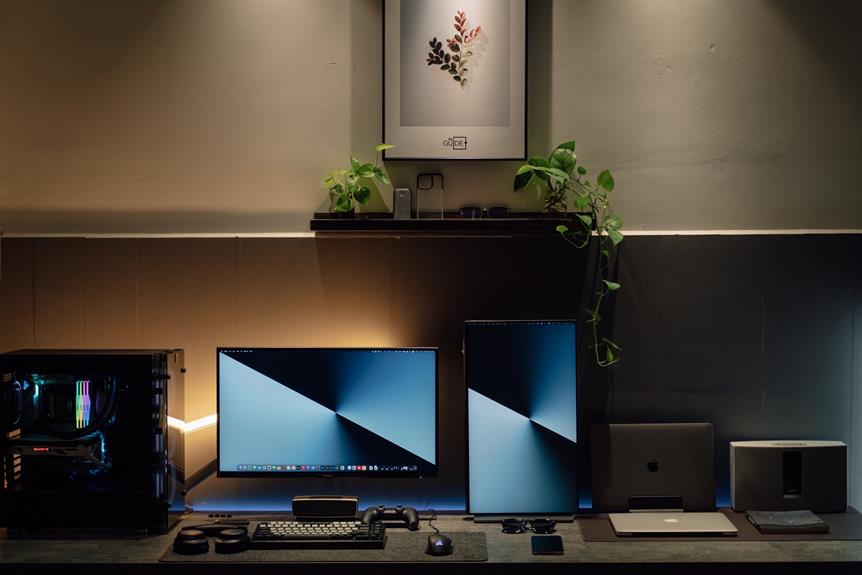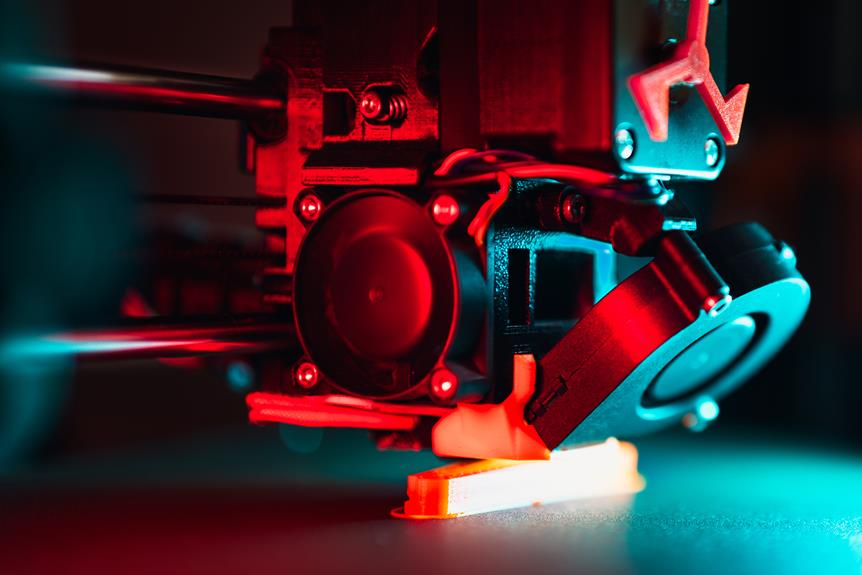Architecture and Construction With 3D Printing: Building the Future
Innovative and groundbreaking, the fusion of architecture and construction with 3D printing is revolutionizing the future of building design.
Marvel at the seamless integration of technology and creativity as structures are brought to life through the precision of 3D printing.
This article delves into the evolution of 3D printing in the architectural and construction industries, highlighting the advantages, impact, and sustainability it offers.
Discover how this cutting-edge technology is pushing boundaries, promoting customization, and paving the way for a liberated future of construction.
Key Takeaways
- 3D printing in architecture and construction has evolved to include large-scale printers capable of constructing entire buildings.
- The use of computer-aided design (CAD) software has streamlined the construction process, allowing for greater customization and flexibility in building designs.
- The sustainability benefits of 3D printing in architecture and construction include efficient material usage, reduced waste, and the elimination of transportation of pre-fabricated components.
- The future of architecture and construction with 3D printing holds potential for further innovation, technological advancements, and the adoption of 3D printing as a mainstream construction method.
The Evolution of 3D Printing in Architecture and Construction
One of the major milestones in the evolution of 3D printing in architecture and construction is the development of large-scale 3D printers capable of constructing entire buildings. This advancement, known as construction 3D printing or additive manufacturing in construction, has revolutionized the industry by offering faster, more cost-effective, and environmentally friendly building solutions.
Architectural 3D printing has the potential to transform the way buildings are designed and constructed. Traditional construction methods often involve time-consuming and labor-intensive processes, but with the advent of construction 3D printing, the process is streamlined and efficient. By using computer-aided design (CAD) software, architects can now create intricate and complex designs that can be translated into tangible structures by the 3D printers.
Additive manufacturing in construction also allows for greater customization and flexibility in building designs. With traditional methods, achieving unique architectural features can be challenging and expensive. However, with 3D printing technology, architects can easily incorporate intricate details and personalized elements into their designs, pushing the boundaries of what is possible in the construction industry.
Furthermore, architectural 3D printing offers sustainability benefits. By utilizing materials efficiently and reducing waste, this technology helps minimize the environmental impact of construction projects. Additionally, the ability to print on-site eliminates the need for transportation of pre-fabricated components, further reducing carbon emissions.
Advantages of Using 3D Printing in Building Design
Several advantages can be gained by using 3D printing in building design. This technology has revolutionized the architecture and construction industry, providing architects and designers with new opportunities to create innovative and sustainable structures. Here are four key advantages of using 3D printing in building design:
- Design Freedom: 3D printing allows architects to explore complex geometries and intricate designs that were previously impossible to achieve using traditional construction methods. This opens up a world of possibilities, enabling architects to push the boundaries of creativity and create unique structures that capture the imagination.
- Time and Cost Efficiency: 3D printing in architecture can significantly reduce the time and cost associated with the construction process. By eliminating the need for traditional formwork and reducing material waste, 3D printing allows for faster construction times and lower project costs. This can be particularly beneficial for large-scale projects where time and budget constraints are critical.
- Customization and Personalization: 3D printing enables architects to customize and personalize building components according to specific requirements. This level of customization allows for greater flexibility in design and can result in buildings that are perfectly tailored to the needs and preferences of the end-users.
- Sustainability: 3D printing in architecture promotes sustainability by minimizing material waste and reducing the carbon footprint of the construction process. Additionally, 3D printing allows for the use of eco-friendly materials and the integration of sustainable design principles, resulting in buildings that are more energy-efficient and environmentally friendly.
The Impact of Large-Scale 3D Printing on Construction Projects
With the advent of large-scale 3D printing technology, construction projects are experiencing a transformative impact on efficiency and innovation. This emerging technology has the potential to revolutionize the way buildings are designed, constructed, and maintained. Large-scale 3D printing allows for the rapid production of complex architectural structures with unparalleled precision and speed. Traditional construction methods often involve time-consuming and labor-intensive processes, but with 3D printing, these constraints can be overcome.
The use of large-scale 3D printing in construction projects offers several advantages. First and foremost, it allows for the creation of intricate and customized designs that were previously difficult or impossible to achieve. This opens up new possibilities for architects and designers to create unique and visually striking buildings. Additionally, 3D printing can significantly reduce material waste by optimizing the use of resources. By printing structures layer by layer, only the necessary amount of material is used, minimizing waste and reducing environmental impact.
Moreover, large-scale 3D printing enables the construction of buildings with improved structural integrity and durability. The ability to print continuous and seamless structures eliminates the need for joints and connections, resulting in stronger and more resilient buildings. This can lead to safer and longer-lasting structures, reducing the need for frequent repairs and maintenance.
Sustainable Design Solutions Enabled by 3D Printing
Through the utilization of 3D printing technology, architects and designers can implement sustainable design solutions that optimize resource utilization and minimize environmental impact. This innovative approach to construction offers numerous benefits that align with the desires of an audience seeking liberation from traditional practices.
Here are four reasons why sustainable design solutions enabled by 3D printing are revolutionizing the field:
- Reduced Waste: 3D printing allows for precise material deposition, minimizing the amount of waste produced during the construction process. This not only reduces the environmental impact but also lowers costs associated with waste disposal.
- Energy Efficiency: By utilizing 3D printing, architects can design structures with optimized geometries that maximize energy efficiency. This includes incorporating features such as passive cooling systems, natural ventilation, and efficient lighting solutions.
- Renewable Materials: 3D printing enables the use of sustainable and renewable materials, such as biopolymers and recycled plastics, reducing the dependence on traditional construction materials that deplete natural resources.
- Customization and Adaptability: With 3D printing, architects can easily customize designs to meet specific needs, resulting in efficient use of space and materials. Additionally, structures can be easily adapted or modified, reducing the need for demolition and reconstruction.
Exploring Innovative Materials for 3D Printed Structures
The utilization of innovative materials in 3D printed structures is revolutionizing the field of architecture and construction. With advancements in technology, architects and engineers are now able to explore a wide range of materials that were previously not feasible for construction. These new materials offer various advantages such as enhanced durability, sustainability, and design flexibility.
One example of an innovative material is bio-concrete, which incorporates bacteria that can self-heal cracks and increase the lifespan of structures. Another material gaining attention is translucent concrete, which allows natural light to filter through, reducing the need for artificial lighting and creating visually stunning designs. Additionally, the use of recycled materials, such as plastic waste or construction debris, is becoming more prevalent, addressing the issue of sustainability in construction.
To further illustrate the potential of innovative materials in 3D printed structures, the following table showcases three materials and their unique properties:
| Material | Properties |
|---|---|
| Bio-concrete | Self-healing, increased durability |
| Translucent concrete | Natural light filtration, aesthetics |
| Recycled materials | Sustainability, waste reduction |
These materials demonstrate the transformative impact of innovative materials in 3D printed structures, allowing architects and engineers to create more sustainable, durable, and visually appealing designs. As technology continues to advance, the possibilities for materials in construction are endless, pushing the boundaries of what is possible in architecture.
Enhancing Structural Integrity With 3D Printed Components
Enhancing structural integrity with 3D printed components is a crucial aspect of architecture and construction.
By reinforcing strength through printing, designers and engineers can create structures that are more resistant to external forces and can withstand greater loads.
Furthermore, optimizing structural performance through 3D printing allows for the creation of complex geometries and lightweight structures, resulting in improved efficiency and resource utilization.
Additionally, the use of 3D printed components can increase the durability of buildings, reducing the need for frequent repairs and maintenance.
Reinforced Strength Through Printing
By incorporating 3D printed components, structural integrity can be significantly enhanced, ensuring reinforced strength in architectural and construction projects. The use of 3D printing technology offers numerous advantages in terms of structural performance, durability, and efficiency.
Here are four key ways in which 3D printing can enhance the strength of architectural and construction projects:
- Customization: 3D printing allows for the creation of complex, customized geometries that can optimize load distribution and increase overall structural stability.
- Material Optimization: By precisely controlling the deposition of materials, 3D printing enables the use of advanced composites and high-performance materials, enhancing the strength and durability of printed components.
- Improved Structural Integration: 3D printed components can be designed to seamlessly integrate with existing structures, improving overall stability and reducing the risk of structural failure.
- Reduced Weight: 3D printing techniques, such as lattice structures, can significantly reduce the weight of printed components without sacrificing strength, resulting in more efficient and cost-effective designs.
Incorporating 3D printed components in architectural and construction projects not only enhances structural integrity but also opens up new possibilities for innovative and sustainable design solutions.
Optimizing Structural Performance
To optimize structural performance and enhance the integrity of architectural and construction projects, 3D printed components offer innovative solutions.
By utilizing this technology, architects and engineers have the ability to create complex geometries and intricate designs that were previously unattainable. This allows for the optimization of material usage, reducing waste and increasing efficiency.
Additionally, 3D printed components can be specifically designed to withstand various loads and stresses, resulting in improved structural integrity. The use of advanced materials, such as carbon fiber reinforced polymers, further enhances the strength and durability of 3D printed structures.
Furthermore, the ability to print on-site enables the construction of customized components that perfectly fit the project requirements, eliminating the need for expensive and time-consuming traditional manufacturing processes.
Increased Durability With Printing
With the utilization of 3D printing technology, the durability of architectural and construction projects can be significantly increased by enhancing the structural integrity of 3D printed components. This innovative approach brings numerous benefits that appeal to an audience seeking liberation in the field of architecture and construction.
- Improved Material Performance: 3D printing allows for the use of advanced materials, such as carbon fiber-reinforced polymers, that offer superior strength and durability compared to traditional construction materials.
- Streamlined Design Complexity: 3D printing enables the creation of complex geometries and intricate designs that are structurally optimized, reducing the risk of weak points and increasing overall durability.
- Enhanced Structural Integration: By 3D printing architectural components directly onto a construction site, the structural integration is seamless, eliminating joints and connections that can weaken the overall structure.
- Customizable Reinforcement: 3D printing allows for the precise placement of reinforcement materials, such as steel or concrete, within 3D printed components, ensuring maximum strength and durability where it is needed most.
By leveraging 3D printing technology, architects and construction professionals can enhance the durability of their projects, offering a liberated approach to building structures that are stronger, more resilient, and longer-lasting.
This leads us to explore 3D printing's role in customization and personalization in architecture.
3D Printing's Role in Customization and Personalization in Architecture
In architecture, 3D printing plays a crucial role in enabling customization and personalization. One of the key benefits is enhanced design flexibility, allowing architects to create unique and intricate shapes that would be difficult to achieve with traditional construction methods.
Additionally, 3D printing allows for efficient material utilization, reducing waste and costs while still maintaining structural integrity. These advantages make 3D printing a promising tool for architects looking to push the boundaries of design and create truly personalized spaces.
Enhanced Design Flexibility
The integration of 3D printing technology in architecture allows for unprecedented levels of design customization and personalization. This enhanced design flexibility provides architects and designers with the ability to create unique and innovative structures that meet the specific needs and desires of their clients.
Here are four ways in which 3D printing enables this:
- Customized shapes and sizes: With 3D printing, architects can easily create complex geometries and intricate designs that were previously difficult or impossible to achieve using traditional construction methods.
- Unique material properties: 3D printing allows for the use of a wide range of materials, including advanced composites and specialized polymers, which can be customized to meet specific performance requirements.
- Tailored aesthetics: By utilizing 3D printing, architects can create highly detailed and visually stunning facades, enabling buildings to become works of art that reflect the individuality of their owners.
- Personalized experiences: 3D printing technology enables the integration of smart systems and interactive elements, allowing buildings to be personalized to enhance the user experience and create spaces that are truly unique and liberating.
Efficient Material Utilization
By optimizing material usage and allowing for precise customization, 3D printing revolutionizes the way architecture is personalized and tailored to individual needs. Traditional construction methods often lead to wastage of materials, resulting in higher costs and environmental impact. However, with 3D printing, architects can now design and create structures with minimal waste, using only the necessary amount of material. This not only reduces construction costs but also contributes to sustainability efforts.
Moreover, 3D printing enables architects to customize and personalize designs to meet the specific requirements of clients. Whether it is creating intricate patterns, unique shapes, or incorporating personalized elements, 3D printing offers unprecedented freedom in architectural design. This level of customization allows architects to create spaces that truly reflect the individuality and preferences of their clients.
Moving forward, the future of construction lies in the integration of automation and robotics with 3D printing, which will further enhance efficiency, speed, and precision in the construction industry.
The Future of Construction: Automation and Robotics With 3D Printing
Automation and robotics are revolutionizing the construction industry through the integration of 3D printing technology. This groundbreaking combination is set to transform the way buildings are designed, constructed, and maintained.
Here are four ways in which automation and robotics with 3D printing are shaping the future of construction:
- Increased speed and efficiency: By automating the construction process, 3D printing allows for rapid and precise fabrication of building components. This significantly reduces construction time and labor costs, leading to faster project completion and improved productivity.
- Enhanced design flexibility: With the ability to create complex shapes and structures, 3D printing enables architects and designers to push the boundaries of traditional construction methods. This newfound design freedom allows for more innovative and sustainable buildings, tailored to meet specific needs and preferences.
- Improved safety and reduced risk: By automating hazardous tasks, such as heavy lifting and working at heights, robotics can enhance worker safety on construction sites. Furthermore, 3D printing can minimize the need for human intervention in dangerous environments, reducing the risk of accidents and injuries.
- Sustainable construction practices: Automation and robotics with 3D printing promote sustainable construction practices by minimizing material waste and optimizing resource utilization. With the ability to print structures with precision and accuracy, this technology reduces the need for excess materials and promotes environmentally friendly building practices.
The integration of automation, robotics, and 3D printing in the construction industry holds immense potential. It not only streamlines the construction process but also opens up new possibilities for architectural design, safety, and sustainability. As this technology continues to advance, it will liberate the industry from traditional constraints, ushering in a new era of construction.
Overcoming Challenges and Pushing Boundaries in 3D Printed Architecture
Innovation and experimentation are key to unlocking the full potential of 3D printed architecture, allowing architects and engineers to overcome challenges and push the boundaries of traditional construction methods. While 3D printing in architecture offers numerous advantages such as cost-effectiveness, sustainability, and design flexibility, it also presents its own set of challenges. These challenges include material limitations, structural integrity, and scalability. However, through continuous research and development, these obstacles are being addressed and overcome.
To illustrate the progress in overcoming challenges and pushing boundaries in 3D printed architecture, the following table showcases notable advancements in the field:
| Challenge | Solution | Result |
|---|---|---|
| Material Limitations | Development of new printable materials | Increased range of materials with improved properties |
| Structural Integrity | Integration of reinforcement and optimization techniques | Enhanced structural stability and durability |
| Scalability | Collaboration with construction industry for large-scale projects | Successful completion of larger and complex structures |
Frequently Asked Questions
How Does 3D Printing Technology Work in the Field of Architecture and Construction?
3D printing technology in the field of architecture and construction works by using additive manufacturing techniques to create three-dimensional objects. It allows for the precise and efficient production of complex structures, reducing costs and construction time.
What Are Some Examples of Real-Life Construction Projects That Have Successfully Utilized 3D Printing?
There have been numerous successful real-life construction projects that have utilized 3D printing technology. These projects have demonstrated the potential of 3D printing in various sectors, including housing, infrastructure, and even space exploration.
Are There Any Limitations or Drawbacks to Using 3D Printing in Building Design?
There are limitations and drawbacks to using 3D printing in building design. These include the cost of equipment and materials, the size limitations of the printers, and the need for skilled operators to ensure quality and accuracy.
How Does 3D Printing Contribute to Sustainable Design Practices in Architecture?
3D printing contributes to sustainable design practices in architecture by reducing waste, energy consumption, and carbon emissions. It allows for precise material usage, efficient construction processes, and the creation of eco-friendly structures that promote environmental preservation and resource conservation.
What Are the Potential Risks and Challenges Associated With Implementing Large-Scale 3D Printing in Construction Projects?
The potential risks and challenges associated with implementing large-scale 3D printing in construction projects include technological limitations, regulatory hurdles, high initial costs, lack of skilled labor, and potential safety concerns.
Conclusion
In conclusion, 3D printing has revolutionized the field of architecture and construction, offering numerous advantages such as increased design flexibility, reduced construction time, and cost-effectiveness.
The use of large-scale 3D printing has the potential to significantly impact construction projects, enabling the creation of sustainable designs and innovative structures.
With the exploration of new materials and the enhancement of structural integrity, 3D printed components are pushing the boundaries of architectural possibilities.
As automation and robotics continue to advance, the future of construction lies in the integration of 3D printing technology.









